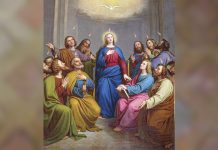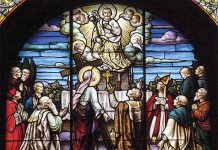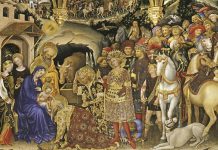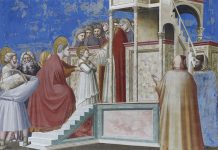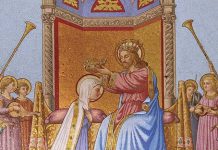Based on Scriptural data, the twenty centuries of the Church’s theological teachings and some selected private revelations, in his latest work Msgr. João acclaims the co-redemptive role of Mary in the Passion of her Divine Son.
Man cannot accomplish any great work without first contemplating it inwardly. A fortiori, the Redemption, an eminently divine act, was first conceived by the God-Man in his Heart. Within this intimate sanctuary, He experienced all the contempt, anguish and humiliations associated with it, and desired them entirely. Only then, “like a mighty man, like a man of war” (Is 42:13), did He undertake the glorious feat for which He had come into the world. This would begin at the Last Supper with the affectionate farewell He bade His beloved ones.
The contrast between Our Lord’s outpouring of divine love in this sublime mystery and the Apostles’ state of soul is eloquent. Yes, even before feeling the arduous weight of the Cross, Jesus would experience in His Sacred Heart the coldness of those closest to Him and to whom He had most especially done good. And not only coldness: indifference and even envy, rebellion and hatred would afflict Him, as the terrible betrayal of Judas demonstrates.
A similar trial would assail Our Lady as She entered those painful and momentous days: the harsh impression that both the Apostles and Heaven itself would witness that drama without manifesting any opposition, in an attitude of neutrality. This absence of sensible reassurance would cause Her untold trials, as will be seen. Nevertheless, in her flawless fidelity, She would become in a most eminent manner the Co-Redemptrix of humanity by her complete association with the Passion of her Son.1
The most sublime farewell
Because of the infinite love He had for His Blessed Mother, Our Lord did not wish to deprive Her of participation in those memorable moments, and so He invited Her to spend the Passover with Him in Jerusalem.
All the Apostles gathered in the Cenacle for the supper. Mary, in an adjacent room with some of the Holy Women, accompanied in her Immaculate Heart all that took place with her Son in the principal room. The culmination of the celebration would be the institution of the Holy Eucharist, a mystery revealed to Her and to St. Joseph by their Son during the colloquies of His childhood years. Since then, Mary had longed to receive this Sacrament and prepared herself for it through innumerable spiritual Communions.
What joy She experienced when Our Lord, after having received Himself in Communion,2 proceeded to the room where She was discreetly following the sublime unfolding of that banquet and gave Her the piece of bread transubstantiated into His Body, Blood, Soul and Divinity… At the Last Supper, Mary was the first to receive Communion from Jesus’ hands! And from that moment on, the Sacred Species would never be consumed within Her,3 allowing Her to participate, in a mystical and entirely unique way, in the Passion of her Divine Son.4
“The hour has come”
One can well imagine the sorrow Mary felt when, at a certain point in the supper, Judas arose to consummate the betrayal by delivering her Divine Son to the Sanhedrin. Our Lady prayed for that wretched man to abandon his evil intent, but he did not correspond to the voice of grace and immersed himself in the darkness dominating Jerusalem.
The traitor having withdrawn, Our Lord gave the sublime farewell discourse recorded by the Beloved Disciple in his Gospel (cf. Jn 14-17), at the end of which all rose to take the road to the Garden of Olives. The Divine Master approached Our Lady and, looking at Her with extreme tenderness, paraphrased the words He had pronounced beforehand in the presence of His beloved ones: “Mother, the hour has come” (cf. Jn 17:1), the dreaded hour of His painful Passion. Before leaving, He asked Her if She consented to that immolation.
Mary was perfectly aware of God’s plan for the Redemption, but the immolated one would be her own Son… How She desired to take His place, to spare Him those horrors. However, once again She decisively pronounced her “fiat”, sensing the sword of sorrow approaching to pierce her Immaculate Heart without mercy, as Simeon had prophesied on the day of the Presentation in the Temple (cf. Lk 2:35).
The Most Pure Virgin remained in the Cenacle. She withdrew to one of the rooms in the building and began to accompany the Saviour mystically. All that happened to Him had an ineffable effect on her, due to the Eucharistic Presence palpitating in her sacred bosom. The moment marked by the Father had come for Her to begin her effective participation in the Redemption.

Detroit Institute of Arts (USA)
The most “sorrowful” angelic ministry
As the Passion was about to begin, the Most High called St. Gabriel into His presence. In addition to commanding him to prevent the devil from using the circumstances to bring about any physical harm to Our Lady, He showed him the torments that Jesus would suffer, and entrusted him, as guardian and divine representative to Mary, to obtain her consent for each one of them. The Archangel therefore found himself in the contradictory position of, without abandoning the mission of defending Her, at the same time being the bearer of the sword destined to pierce her most sweet Heart!
Then began a most arduous interior dialogue that would continue throughout the Passion. As St. Gabriel presented her with each sip of the chalice that needed to be taken, Our Lady analysed it, accepting the suffering it would cause Jesus and offered it to God, rendering her profound and most pure consent that this torment would be effected in Him. No drop of blood, no wound, no offense escaped this supreme rule imposed by the Eternal Father for the unfolding of the martyrdom of the God-Man. It can be said that Mary suffered twice – first on the mystical plane, then the physical – so that somehow her Son would suffer a little less…
From slumber to flight
As this sublime and painful dialogue began, the Divine Redeemer arrived with His disciples in the Garden of Olives. There He invited St. Peter, St. John and St. James to watch with Him, and He went on a little further to pray, His soul “very sorrowful, even to death” (Mk 14: 34).
Prostrate with His face to the ground, He had experiential knowledge of the sufferings He was to endure, bearing beforehand in His soul the pains that would be felt in His most holy flesh. To this was added the vision of humanity’s ingratitude throughout history. It would scorn the Most Precious Blood about to be shed through a folly of love. Jesus weighed the apparent uselessness of this sacrifice and His anguish increased, aggravated by the apathy of the three especially called ones who had fallen into a heavy sleep – fruit of the selfishness still entrenched in their souls.
Our Lady was greatly distressed to realize that Jesus knew of her consent to such torments, which caused in His human nature, endowed with the most perfect filial spirit, the sensation of being abandoned by His Mother. This temptation would persist in various ways during the Passion as one of His greatest sorrows.
In extreme anguish, Our Lord pleaded: “Father, if Thou art willing, remove this cup from Me; nevertheless not My will, but Thine, be done”(Lk 22:42). Mary, seeing the sufferings her Son would undergo, joined herself to this request. And her plea received an answer: an Angel handed Jesus a chalice, containing a mysterious liquid that gave Him strength to continue.
“Rise, let us be going; see, My betrayer is at hand” (Mt 26:46), He exclaimed to the three chosen ones immersed in a torpid and melancholy sleep. At the Master’s warning they awoke with a start, for the loud clamour of the crowd approaching to arrest Him could already be heard. The Apostles and disciples fled, overcome with fear. Only St. John would not abandon Jesus, fulfilling his mission to accompany the Blessed Virgin Mary during the Passion.
With their sentence issued, the Sanhedrin needed the Roman power to ratify the condemnation, as they had no right to execute a prisoner. The sun was beginning to appear on the horizon and Jesus had to be taken to the Praetorium.

The Holy One was mocked
The Gospels tell us that although Pilate, convinced of Our Lord’s innocence, did not believe the false incriminations against Him and was determined to release Him, the insistence of the accusers brought his cowardice to the fore, and the Roman governor consented to punish Him.
With His hands tied, Jesus was led out to be scourged and, “oppressed […] yet he opened not His mouth; like a lamb that is led to the slaughter” (Is 53:7). The executioners stripped Him, tied Him to a small column and flogged Him with unheard-of cruelty. As the scourges struck the Sacred Body of Jesus, Mary felt the same blows in her Heart, suffering to the point of almost fainting.
As Our Lord had revealed His royalty, they also wanted to mock Him specifically on that point. In another area of the palace, those brutish men dressed Him in the purple cloak of derision and did with Him as they pleased: they slapped Him, spat on His face, and pushed Him until He fell to the ground. Their depravity reached a peak when, in a parody of a coronation, they placed a kind of helmet woven with branches full of very large thorns on His head.
At that moment, the terrible diadem mystically pierced the Heart of Mary, causing Her to experience the same pains and humiliations as her Divine Son.
The way to Calvary

Not even the heart-rending spectacle of the Ecce Homo moved the hearts of the populace instigated by their leaders. Afraid to compromise his prestige before the august emperor, Pilate condemned the Innocent One.
When the Cross was presented to Him, Jesus received it with emotion, kissed it and hastened to place it on His shoulders to start out on the road to Calvary. The crowd around Him let out hellish cries; many laughed, threw stones at Him or pushed Him, causing Him to fall with the Cross, while the soldiers beat Him continually.
In the midst of this pandemonium, Our Lady walked through the streets of Jerusalem, trying to accompany Jesus closely. When She saw that her Son, oppressed by the weight of the Cross, had fallen for the first time with His face on the ground, She ran to console Him. At that moment, not only Angels and men, but the whole universe stopped to contemplate one of the most moving scenes in history: the encounter of the Mother with the Son fallen beneath the Cross.
When He arose, His face all bloodied, He gazed at Her with a look of poignant pain and sweetness. The adoration of the Virgin, pervaded with veneration and tenderness, was a precious balm that soothed the Redeemer’s Heart and gave Him strength to resume His path! Other falls of the adorable Son of Mary followed along the way to Calvary, but She realized that it was the divine will that She no longer intervene.
The first stigmatist
When Jesus reached the height of Calvary, He meekly laid Himself on the Cross, indicating His willingness to be nailed upon it. A horrible scene then followed. A soldier pulled the nails out of a bag, grasped Jesus’ left arm and took the hammer to drive in the first nail. The Blessed Virgin felt She could not endure this sight and turned her face away. The sound of those blows and the soft groans of her Divine Son resounded in a very cruel way in the maternal Heart of Mary, which trembled violently.
To nail the right arm of Jesus, the muscles of which had contracted due to the perforation of the other arm, the tormentors had to stretch it so hard that the left hand threatened to tear or become dislocated. Lastly, as they nailed both feet, the pains experienced by Our Lady reached such a height that there are no human words to describe them!
It can be said that Mary takes precedence among all the Saints in history who received the stigmata of the Passion, although in Her it was a strictly spiritual phenomenon. Such were her sufferings in union with her Son due to those wounds.
Mary’s steadfastness
From the height of the Cross, Jesus contemplated the crowd around Him and, in the centre, His Mother. With unspeakable compassion, She remained standing (cf. Jn 19:25), with St. John at her side. Would it not have been more beautiful if Mary were prostrate on the ground or kneeling? No, because She participated in that immolation. Her posture meant that She lived the Passion together with her Son, as a privileged partner in the Redemption.
Our Lady’s attitude was a great consolation for the God-Man: her compassion strengthened Him, her tears soothed His Sacred Heart, her steadfastness encouraged Him to continue until the end. In Her, He saw the perfect correspondence with everything He had given to humanity since the Incarnation. In Her, His Blood was entirely fruitful. But above all, in the Immaculate Heart of Mary, He found His own Passion reflected! Both Hearts, which form one, were nailed together to the Cross.
At that apex of pain, Jesus looked lovingly at Mary and, referring to the disciple who was supporting Her, said: “Woman, behold, your son!” (Jn 19:26) He then gave Her to St. John as Mother: “Behold, your mother!” (Jn 19:27). His intention was clear and indicated the deep maternal relationship She would have with all the elect.
The mystery of the abandonment of a God
When noon came, thick clouds began to cover the firmament; the sun darkened and it became night. The solitude around Jesus intensified and the last and most strenuous temptations presented themselves to Him.
When the Lion of Judah cried aloud “My God, my God, why hast Thou forsaken Me?” (Mt 27:46), He showed that He was undergoing the worst of all sufferings: the feeling of being abandoned by God! This is a mystery incomprehensible even to the Angels, for as God, how could He feel forsaken by God? To this was added the perplexity of judging Himself to have been in some measure abandoned by Our Lady, despite His full certainty that She would never betray Him.
Unspeakable anguish invaded Mary’s most holy soul in this final phase. Her supreme suffering consisted in feeling her own axiology rent as She discerned these trials in the divine gaze of her Son, unable to approach Him to console Him, to alleviate His pains, to assure Him that neither God nor She had forsaken Him, and still having to consent to the contrary. The Sorrowful Mother, however, knew how to hope against all hope, to trust in the absurd, to advance in the midst of contradiction.

“Consummatum est”
Finally, when Our Lord realized that His time had come, He exclaimed, “It is finished” (Jn 19:30). And after uttering a painful cry that echoed throughout the universe, He concluded in a soft tone of voice, “Father, into Thy hands I commit My spirit!” (Lk 23:46). Bowing His head, He expired.
Devastated by grief and shedding precious tears before the consummation of the divine holocaust, Our Lady came very close to losing consciousness. But once again, She remained standing by the Cross, like a victorious banner proclaiming faith in the glories of the Resurrection.
God the Father would yet ask Our Lady for one final sacrifice. When the divine Body could shed no more Blood for the Redemption of men, Longinus wounded Jesus’ adorable side with his spear, piercing the Sacred Heart and, consequently, also the Immaculate Heart of Mary. The tears shed by Mary with this last pain united with the Saviour’s Blood and Lymph, giving birth to the Holy Church.
Co-Redemptrix of the human race
Having contemplated various aspects of the compassion – etymologically, to suffer with – of Our Lady, we understand the magnitude of Her cooperation in the mystery of Redemption, eminent among all others and even, by divine sovereign will, necessary.
The Cross, comfort to Catholics of all time, was Mary’s greatest sorrow. If it is true that Our Lady did not suffer physically – as far as her virginal body is concerned, without considering her extremely delicate sensibility – She endured a plenitude of spiritual suffering unattainable by any human creature.
Moreover, She penetrated into the soul of her Divine Son and discerned the immensity of His suffering in weighing the sins of mankind resulting from the rejection of His torments. Wishing to alleviate this pain to the utmost, in her maternal love for mankind, She interceded for all who would come in the future, joining her prayers and tears to the Most Precious Redeeming Blood. This is why it can be safely stated that the benefits we receive in the plan of grace were also obtained by the Tearful Mother.

Another aspect to consider regarding Our Lady’s participation in the Passion is a reality mentioned at the beginning of this article. When She received Communion at the Last Supper, the Holy Species remained within Her and never left Her. With the Death of Jesus, a profound mystery was worked, which our intelligence cannot grasp: despite the separation of the Soul from the Body, both remained united to the divinity in the Person of the Word. This phenomenon took place in the Eucharist that was in Mary, so that not only the whole Passion, but even the Death of Our Lord, took place within Her.
Regarding this point, Dr. Plinio very rightly notes: “This forms a very beautiful contrast and affirms the victory of Our Lord over the devil in an indescribably glorious manner. For, during the Passion, while He was tied to the pillar, carrying the Cross, being crucified and even dying, He found Himself in His Paradise, which is Our Lady, and thus triumphed in the midst of defeat.”5
Given these reasons, the author raises his request to Our Lord Jesus Christ for the coming of the day when the Church, in her infallibility, solemnly declares the dogma of the Co-Redemption of the Blessed Virgin Mary. ◊
Taken, with adaptations, from:
Maria Santíssima! O Paraíso de Deus revelado aos homens.
[Mary Most Holy! God’s Paradise Revealed to Men.]
São Paulo: Arautos do Evangelho,2020, v.II, p.451-492
Notes
1 Regarding the participation of Our Lady in the Redemption, Benedict XV declares: “The Doctors of the Church commonly teach that the Blessed Virgin Mary, who seemed absent in the public life of Jesus Christ, by divine disposition was at His side when He was put to death and nailed to the Cross. In communion with her suffering and agonizing Son, She endured pain and in a certain way died with Him; She renounced her maternal rights over her Son for the salvation of men; and, to appease divine justice as much as She could, She immolated her Son, so that it may be rightly stated that, with Christ, She redeemed the human race” (BENEDICT XV. Inter sodalicia: AAS 10 [1918], 182). In the same sense Pius XI states: “The august Virgin, conceived without original sin, was chosen as the Mother of Christ precisely to take part in the Redemption of mankind” (PIUS XI. Auspicatus profecto: AAS 25 [1933], 80); and Pius XII: “It was She, the second Eve, who, free from all sin, original or personal, and always most intimately united with her Son, offered Him on Golgotha to the Eternal Father for all the children of Adam, sin-stained by his unhappy fall, and her mother’s rights and her mother’s love were included in the holocaust […]. Finally, bearing with courage and confidence the tremendous burden of her sorrows and desolation, She, truly the Queen of Martyrs, more than all the faithful ‘filled up those things that are wanting of the sufferings of Christ…for His Body, which is the Church’ (Col 1:24)” (PIUS XII. Mystici Corporis Christi, n.106: AAS 35[1943], 247-248).
2 Cf. ST. THOMAS AQUINAS. Summa Theologiæ. III, q.81, a.1.
3 It is common doctrine among the most highly regarded Mariologists that Our Lady has received, to an eminent degree, all the graces granted to the Saints throughout the course of history and which were fitting to Her. This principle seems to confirm the granting of the Eucharistic permanence to the Blessed Virgin (cf. ALASTRUEY, Gregório. Tratado de la Virgen Santísima. 4.ed. Madrid: BAC, 1956, p.687-688; GARRIGOU-LAGRANGE, OP, Réginald. La Mère du Sauveur et notre vie intérieure. Paris: Du Cerf, 1948, p.135-136).
4 As St. Thomas explains, in the Eucharist, the Body of Jesus is found as it is at the moment, so that the participants in the Last Supper were the only ones to receive Him in Communion while He was in a passible state, capable of suffering (cf. ST. THOMAS AQUINAS, op. cit., a.3).
5 CORRÊA DE OLIVEIRA, Plinio. Talk. São Paulo, April 18, 1981.



